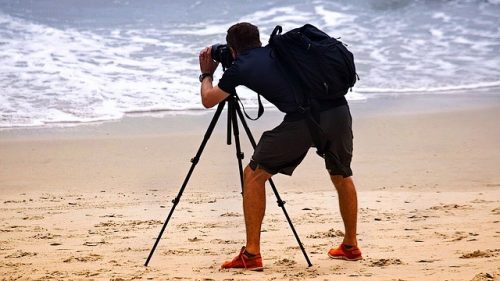
As beautiful as it is, the beach can be a harsh environment for our gear. Sand gets into your tripod locks. Salt spray will corrode your camera and lenses. A healthy splash of water will devastate a camera. There are steps you can take to protect your camera gear. Here are some tips to help you keep your camera, lenses and tripod protected from the sand and surf.

Cover your Canon camera from Beachcamera.com with rain gear. It's obvious advice - the best way to prevent moisture from damaging your camera is to keep your camera and lenses dry. Cover as much of the camera body and lens as you can with a waterproof camera cover.
Do not change lenses out on the open beach. Each time you change a lens it's an opportunity for sand, salt or water to get into your camera body or on the lens contacts. Dust on sensors can be cleaned. Corrosion on the contacts is a whole other problem. Try to pick one lens and shoot with it for the entire day when you’re at the beach. If you must change lenses, always change lenses inside your car or inside a building where the wind isn’t blowing the sand around. This way you’ll lessen the chance that sand grains get inside your camera body
Do not store your camera on the towel next to you. Keep it somewhere safe both for security and from the elements. Keep it safe from the sand and ocean mist with the Nikon All Weather Sport Camera Case with Carabiner from Beachcamera.com. It’s the perfect camera protector that will attach to your beach bag or backpack with a Bungee rope belt harness.

Before removing the lens, use a blower around where the lens attaches to the body. Be thorough, because this can prevent packed sand from falling into the camera.

Microfiber cloths are great to carry in your bag, but wet lens wipes are best when dealing with sand. If you just use a soft cloth, sand particles can actually scratch the glass while you’re dragging it around the front of the lens. Use a blower first to get the loose sand off, then dab a wet wipe over the lens. Flip the wipe over and now you’re good to drag it around and clean the lens. Remember, the less dragging the better.
Protect the front element of your lens with a filter. If you're already shooting with a polarizer or neutral density filter, you're good to go. If not, use a UV filter, especially on windy days. Sand in the air will scrub away at the protective coating on your lens. Salt isn't good for it either. Over time, your filters will degrade but replacing them is far cheaper than replacing good glass.

After your beach visit, wipe down your Sony camera body and lens. Just take a few wet lens wipes or a microfiber cloth and a blower and give the camera a good once-over. This is to remove sea mist that may have built up or loose sand before you put it back in your camera bag. It’ll also clean the caked sunscreen and sweat from the LCD screen and viewfinder. Pay attention to any white spots on your gear. If you see some, that's probably salt. Clean again until the salt is gone. Don’t be afraid to take your camera to the beach. With a little extra attention, it’ll be just fine.